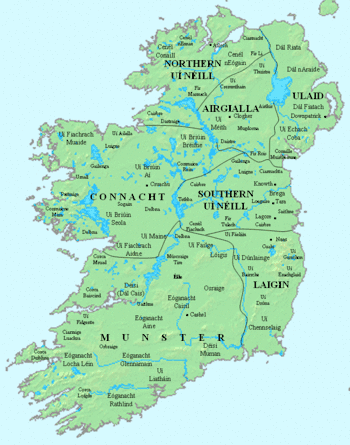Conmhaícne Mara
The Conmhaícne Mara or Conmaicne Mara (the Conmaicne of the sea), were an early people of Ireland. Their tuath settled in the extreme west of County Galway, giving their name to Connemara, an anglicised form of Conmhaicne Mara.
Origin
The Conmhaícne or Conmaicne were an people of early Ireland, perhaps related to the Laigin, who dispersed to various parts of Ireland. They settled in Connacht and Longford, giving their name to several Conmaicne territories. [1][2] Other branches of the Conmaicne located in County Galway included the Conmaícne Dúna Móir (Conmaicne of Dunmore) and the Conmhaícne Cúile Toland (Conmaicne of Cuile-Toland).
Territory

Conmhaícne Mara comprised all of the barony of Ballynahinch and the civil parish of Inishbofin, which is in the barony of Murrisk. The territory contains the five civil parishes of Ballynakill/Baile na Cille, Ballindoon, Moyrus/Maigh Iorras, Omey/Iomaidh Fheicín and Inishbofin/Inis Bó Fine. The territory contains the five Catholic parishes of An Clochán (Clifden, Omey & Ballindoon), Iorras Ainbhtheach (Carna), Cloch na Rón/(Roundstone), Baile na Cille (Ballynakill) and Inis Bó Fine/(*Inishbofin (County Galway)).[3]
The area of County Galway in which Connemara lies is known as Iar Connacht i.e. the portion of County Galway west of Lough Corrib and a small piece of County Mayo. The parish of Kilconickny, which means "church of the Conmaicne"is located west of the town of Loughrea.
History
The chiefs of the Conmaicne Mara were the O’Kealys, and their cadets were the MacConneelys, O’Devaneys, and O’Clohertys, with the O’Falons [Folan] as their hereditary brehons. The O’Kealys relocated to Ui Oirbsen, but they were to find themselves imposed upon again after just a few decades. The MacConneelys stayed in their home at Ballyconneely Peninsula, but soon found themselves neighbors of the O’Flahertys.
A court inquisition in 1607 includes the following as leading chiefs of name in the barony of Ballynahinch: O’Flaherty of Bunowen, MacConroy, MacConnor, MacDonough, O’Duan, O’Lee, and MacConneely. MacConnor and MacDonough, are chiefs of branches that separated from the O’Flahertys, while the two after that, O’Duan and O’Lee, headed old followers of that family. The MacConneelys were the eldest cadets of the O’Kealys of Conmaicne Mara.[4]
Annalistic references
- AI1016.6 The slaughter of Ára, in which Ua Lochlainn, royal heir of Corcu Modruad, was killed in Port Ciaráin in Ára. It was the Conmaicne who slew him.
- AI1016.8 Death of Muiredach son of Cadla, king of Conmaicne Mara.
See also
- Uí Fiachrach Aidhne
- Clann Fhergail
- Clann Taidg
- Delbhna Tir Dha Locha
- Muintir Murchada
- Senchineoil
- Uí Maine
- Soghain
- Trícha Máenmaige
- Uí Díarmata
- Cóiced Ol nEchmacht
- Síol Anmchadha
- Iar Connacht
- Maigh Seola
- Cenél Áeda na hEchtge
References
- MacKillop 2004.
- AFM, p. 417.
- Hardiman 1846, p. 365.
- Hamilton, Chuck (12 September 2013). "Notes from the Ninth Circle: The MacConroys in Iar Connacht". Notesfromtheninthcircle.blogspot.ie. Retrieved 5 February 2014.
Secondary sources
- Annals of the Four Masters, ed. & tr. John O'Donovan (1856). Annála Rioghachta Éireann. Annals of the Kingdom of Ireland by the Four Masters... with a Translation and Copious Notes. 7 vols (2nd ed.). Dublin: Royal Irish Academy. CELT editions. Full scans at Internet Archive: Vol. 1; Vol. 2; Vol. 3; Vol. 4; Vol. 5; Vol. 6; Indices.
- MacKillop, James (2004). "Conmaicne. Oxford Reference.". A Dictionary of Celtic Mythology. Oxford University Press.CS1 maint: ref=harv (link)
- A Chorographical Description of West or H-Iar Connaught written A.D. 1684 by Roderic O'Flaherty ESQ with notes and Illustrations by, James Hardiman M.R.I.A., Irish Archaeological Society, 1846.
Bibliography
- Medieval Ireland: Territorial, Political and Economic Divisions, Paul MacCotter, Four Courts Press, 2008. ISBN 978-1-84682-098-4